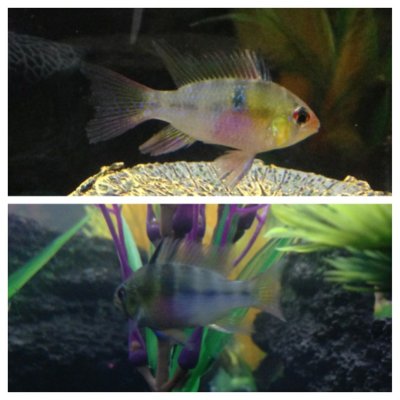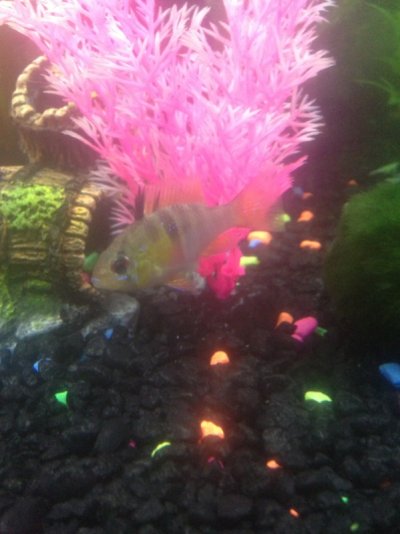You are using an out of date browser. It may not display this or other websites correctly.
You should upgrade or use an alternative browser.
You should upgrade or use an alternative browser.
German blue rams
- Thread starter KKAY27
- Start date
The friendliest place on the web for anyone with an interest in aquariums or fish keeping!
If you have answers, please help by responding to the unanswered posts.
If you have answers, please help by responding to the unanswered posts.
Goldfish loach boy
Aquarium Advice Addict
- Joined
- Mar 16, 2013
- Messages
- 3,167
Top is a female, not sure about bottom but it looks like a female too, can you get a better pic I the bottom one?
Oohitsae
Aquarium Advice Addict
Both are female. See the pink on their bellies? Easiest way to sex GBR's
bshenanagins
Aquarium Advice Addict
- Joined
- Feb 18, 2013
- Messages
- 1,583
Both are female. See the pink on their bellies? Easiest way to sex GBR's
Agreed, also the blue speckle covering the black spot. Not always a sure fire conclusion on that last note but def. the pink is a giveaway
Samzter
Aquarium Advice Addict
I just recently purchased two german blue rams. They are kind of small right now and the person who sold them to me couldn't tell if they were male or females! I wanted a male and female so i could have babies! Can anybody tell there gender?
Both are female. By the looks of things! Btw there's more to it then sticking a male and female in the same tank. Have a read of this thing I found:
BREEDING GERMAN BLUE RAMS
German blue rams are suprisingly easy once you have an established pair. GBR grow to about six to seven centimetres. They like to eat bloodworms and flakes, river shrimp and lots more! The cons of these stunning looking fish is that they need pristine water quality. They're colouring is unique with their shimmering blue scales. They can breed as early on as four months but usually from six months +.
SEXING:
The female fish is smaller than the male and have more of a pink underbelly in her ventral region. If you look at the anterior region of the dorsal fin, you can see that her fin rays are less developed. It is also common for females to have a plumper body shape and more rounded edging of the tailfin. The back of the dorsal and anal fins have a more pointy edge in the male ram, and the tail fin is also more sharply edged. The male ram can be recognized on his V-shaped tail fin and the elongated second ray that is present in the dorsal fin.
BREEDING
When its time for breeding, the red patch on the belly of the female will grow bigger and become much brighter than normally. A flat stone will be cleaned or a pit will be dug out by either of the pair. The couple will also start nudging each other and/or twirling, and the male fish can dart away at a high pace or slide against the body of the female fish
During spawning, the female will place small adhesive eggs on the flat stones or in the small pits. The eggs are 0.9-1.5 mm in length (0.035-0.059 inches). A typical batch will consist of 150-300 eggs, but some batches contain no more than 20 eggs while others contain over 500 eggs.
Both the male and the female fish should be allowed to stay with the offspring because this species practise biparental brood care and the parents work together to care for the eggs and guard the territory. A parent will fan fresh water over the eggs to prevent attacks from fungi and bacteria. The parents will also eat unfertile eggs to prevent them from turning into breeding grounds for pathogens.
The eggs will normally hatch within 40 hours if the water is kept in the upper part of the recommended temperature range. It will then take roughly 5 days before the offspring becomes free swimming. The free swimming fry will be kept in a dense school and be cared for by the parents. They will be escorted by their mother or father during foraging.
Don’t lose heart if the first few spawnings are unsuccessful. A lot of things can go wrong and it is common for German blue rams to spawn a few times before they get everything right. They might for instance eat a few batches before they become good parents. Once they have started breeding, you can however expect a new batch once a month or so. Young pairs are known to fight quite a lot and the aquarium must contain plenty of hiding spots to avoid stress and injury.
If your couple continues to eat their offspring even after several spawnings it can be a sight of distress in the aquarium. Try to figure out what stresses your fish and do your best to make the aquarium more relaxing for them.
TheCommunityCichlid
Aquarium Advice Addict
Both are female. See the pink on their bellies? Easiest way to sex GBR's
Not a sure way to tell, but in this instance both are defiantly female.
KKAY27
Aquarium Advice Freak
Thanks for the help everybody!! I plan on getting a male now that i know how to tell what they are!
Fishman007
Aquarium Advice Addict
Well the top is a female but i cant tell what the bottom one is please get a better picture of it
KKAY27
Aquarium Advice Freak
TheCommunityCichlid
Aquarium Advice Addict
Two females
Fishman007
Aquarium Advice Addict
Yeah i understand and yeah those are both females as community said.
Similar threads
- Replies
- 4
- Views
- 439
- Replies
- 3
- Views
- 820
- Replies
- 5
- Views
- 968
- Replies
- 4
- Views
- 384


